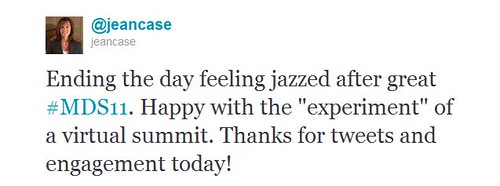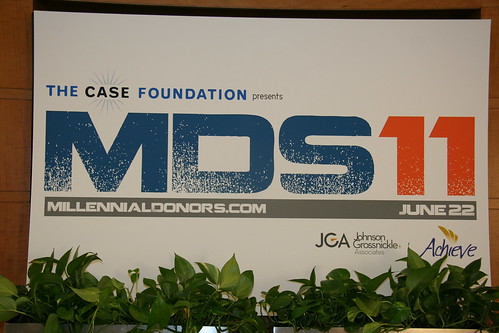
Note from Beth: Last June, I live blogged the virtual Millennial Donor Summit and it was an interesting experience. So I was very interested to hear about the lessons learned report about the virtual summit and Kari agreed to write a guest post. Hosting engaging online events and learning experiences has been of interest to me over the past ten years and the question of whether or not virtual events replace the face-to-face or how to best blend together.

Will the Virtual Summit Replace Face-to-Face? New Report Details How to Plan and Execute a Successful Online Convening, Guest Post by Kari Dunn Saratovsky
After triple checking to ensure you have your iPad, mobile phone, laptop, and all of your respective chargers in tow — you board a flight, land in a new city, and head straight for the convention center. For the next three days you shuffle around an air-conditioned hall and hop between plenary sessions and breakouts. If you’re lucky (and the conference budget hasn’t been completely slashed) you may even find the joy in a lovely rubber chicken plate lunch. Sound familiar? This scenario plays out time and again in cities across the country. But in these tough economic times, new advances in technology are making virtual events an interesting and compelling alternative to the traditional in-person conference.
This past June, the Case Foundation, Achieve, and JGA teamed up for a little virtual experiment of our own. We convened the 2011 Millennial Donor Summit (MDS11) as a way to build a more engaged conversation around the Millennial Donor Survey conducted earlier in the year. But, rather than having 1,000 people come to us, we took the plenaries, breakouts, and exhibit hall to them through the technology of a virtual summit. The summit was an opportunity to spotlight the unique characteristics of the rising generation and to help nonprofit executives attract and engage Millennials in their work – and we couldn’t think of a better topic on which to convene than through this new medium.
The Summit was an experiment for us as conveners – but also for the speakers and participants since for the most part no one had participated in this kind of convening before. In the past month, we shared some of our biggest takeaways and lessons learned through a four-part blog series on the Case Foundation site. Today these findings, tips, and tricks for conducting a successful online convening are now all available in the report, “Your Virtual Seat Awaits.” . We hope the report will offer some practical tips for individuals and organizations who are interested in experimenting with new approaches to the traditional conference from the perspective of the conveners.
While some will argue that an online convening could never replace the value of the relationships built and the networking opportunities that stem from being in the same physical location at the same time – there is a strong argument to be made for keeping costs and travel expenses at a minimum and involving individuals from a wide spectrum of backgrounds and industries who may not be able to otherwise participate.
What’s more, the shortfalls of the traditional meeting model, with an on-stage presenter talking to a passive audience, is replaced by a much more interactive and dynamic exchange that allows for dialogue not only between speakers and participants but between participants themselves. The Twitter conversations were so robust during MDS11, that a group even spun out their own weekly #MillennialChat group where they take on a different topic each week related to millennial engagement. The chat on Tuesday, October 11th will focus on the “Your Virtual Seat Awaits” report, and anyone can join the discussion.

While the report goes into much greater detail, here are five of the key takeaways we found while planning the Millennial Donor Summit:
1. Solid planning and execution: Virtual conferences need good planning and execution. It takes time and effort to get this right, and without appropriate planning on the front end you risk losing control of your participants in a bigger way than if you were trying to troubleshoot in person.
2. Trusted technology provider: Streaming and live video is wonderful in concept, but it needs to have a solid technology foundation so it will work no matter what the participant’s environment happens to be. Just because the technology works on your side doesn’t mean the users aren’t running into difficulty with their own firewalls, connection speeds, etc.
3. High energy, informative, and interactive sessions: Just like an in-person convening, without these elements, a conference can fall flat and disappoint those who have set aside the time and paid to come together to be inspired. The same holds true in a virtual setting, but getting that right can be more of a challenge.
4. Rockstar panelists: To create interaction, presenters need to be creative, well-prepared, and have a plan for engaging the audience in the Q&A process. Engagement cannot be left up to chance, and is vital to the success of a session. Suddenly in a virtual format, participants have easier access to speakers—if the speaker is responsive to comments and questions from audience members the session will be much more engaging for all.
5. Strong visual appeal: Just like an in-person conference, the appearance of a virtual conference requires attention as well. When our site was initially set up, it featured a bunch of white men in business suits hanging around the main entrance—and that was not the look and feel we were going for so we worked to diversify the crowd. Signage is also important so participants know exactly where to go and how to navigate to the various venues, be it the discussion lounges, registration, expo hall, etc.
Perhaps some of the above mentioned sound like common sense, but the small details can make a world of difference in a virtual setting. Have you participated in or presented at a virtual meeting? If so, what might you add as your biggest takeaways? Do you think there will be a time when the virtual summit replaces the in-person conference, or will a hybrid of the two eventually become the norm?
Kari Dunn Saratovsky (@socialcitizen) is Senior Advisor to the Case Foundation. With experiences in both the government and nonprofit sectors, she finds her favorite role is that of a connector — connecting passionate people, good ideas, and new approaches in an effort to address social problems.

Leave a Reply